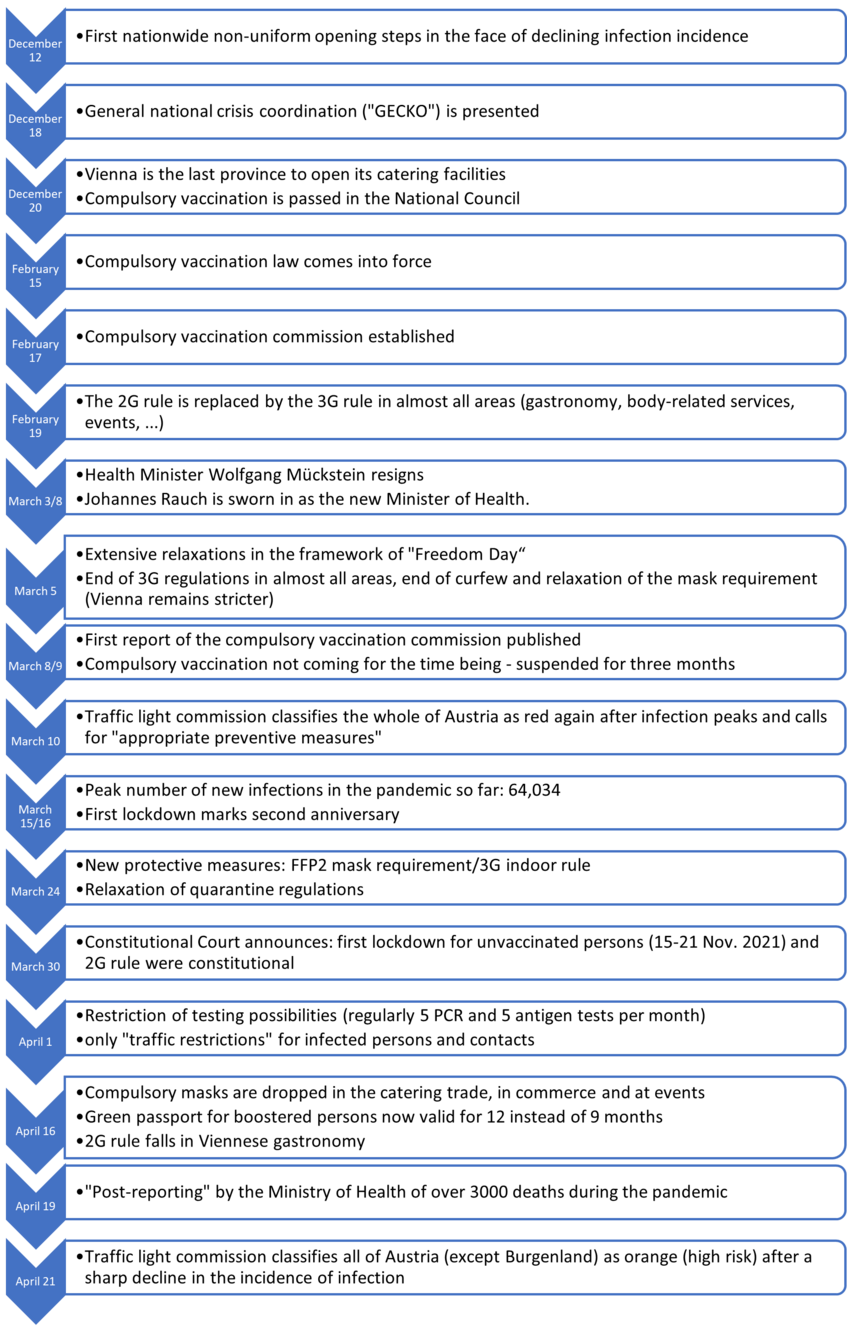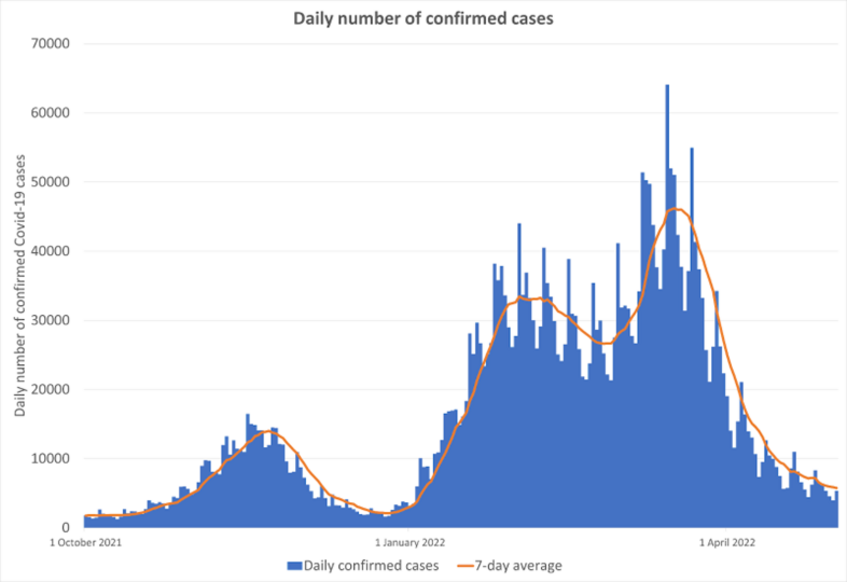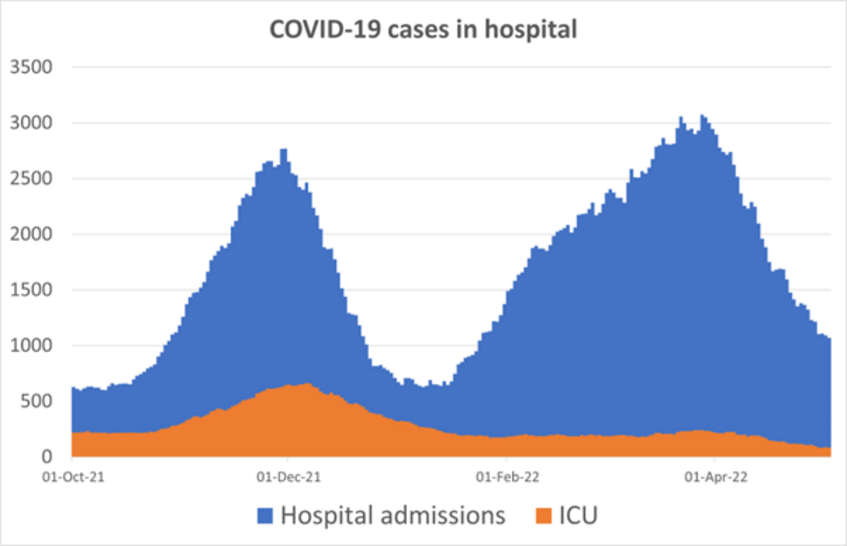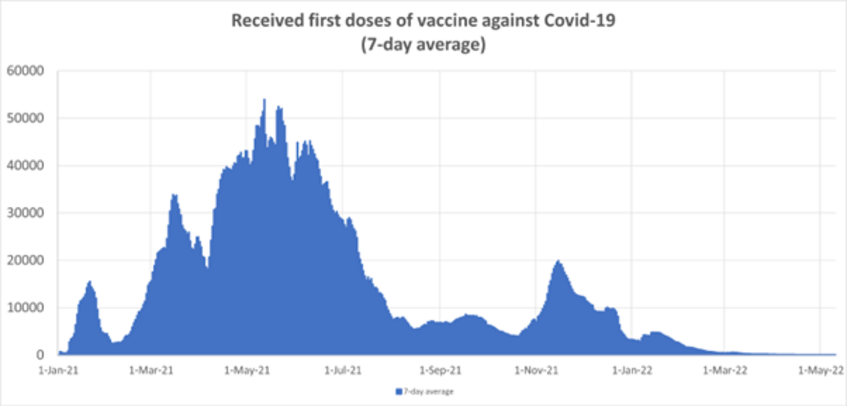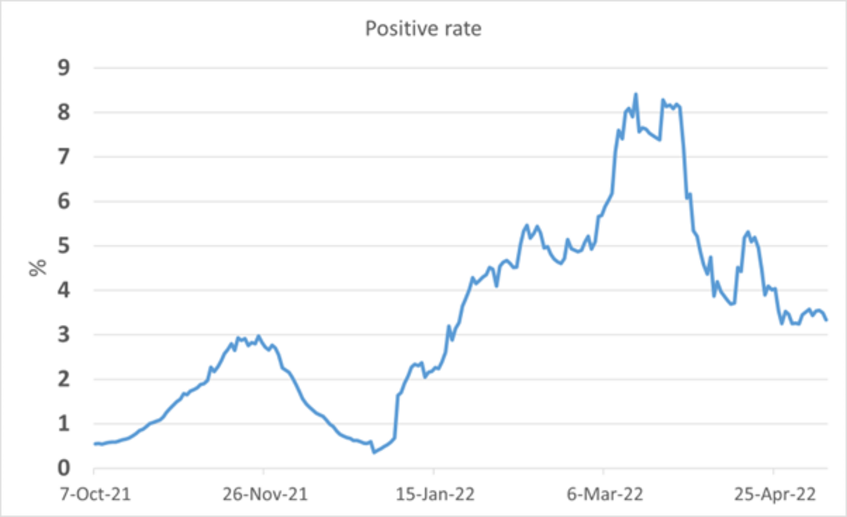30.05.2022 - PDF
Chronology on the Corona Crisis in Austria - Part 7: The Delta Lockdown, the Omicron Wave and the "Spring Awakening"
In mid-December 2021, the general lockdown was ended in view of the falling case numbers in the context of the delta wave. The so-called "lockdown for the unvaccinated", which had been in force since November 2021, ended at the end of January 2022. The Constitutional Court later confirmed the controversial measure as constitutional. Compared to "Delta", the newly emerging Omicron variant showed milder disease courses, but there was still a strain on critical infrastructure due to staff absences.
The Compulsory Vaccination Act was passed on January 20th, 2022 and the compulsory vaccination officially came into force on February 5th, 2022. Only a little later, at the beginning of March, a suspension of the compulsory vaccination was announced on the grounds of milder courses of the Omicron variant.
In February 2022, wide openings were announced for March ("spring awakening"). Shortly after the openings, the Omicron wave peaked. After the Omicron wave subsided, the situation eased further, allowing for further easing of measures.
By Christina Walcherberger, Florian Holl, Markus Pollak, Nikolaus Kowarz and Julia Partheymüller
This article documents the key events, developments and measures of the Corona crisis in Austria in the period from December 2021 to May 2022. In six previous articles on the chronology of the Corona crisis in Austria, the first lockdown in spring 2020, the subsequent phase of normalization in summer 2020 and the beginning of the second wave in autumn 2020 have already been described. Furthermore, the lockdown in winter 2020/21 and the third wave in spring 2021 have already been described in earlier articles. Finally, we looked at the spread of the "Delta" variant in autumn 2021. In this article, we highlight the most important developments in the period from December 2021 to May 2022.
December 2021 - January 2022: Ending the Delta Lockdown, the new enemy Omicron and the Mandatory Vaccination Act
Opening steps were announced for December 12th, 2021, ending the Delta lockdown that had lasted for a total of 21 days since November. However, the openings were not uniformly distributed across the federal territory. Burgenland, Tyrol and Vorarlberg opened restaurants, accommodations and culture and their retail sectors under the 2G rule as of December 12th, 2021. Lower Austria, Salzburg and Styria waited until December 17th, 2021 to do so. Upper Austria remained in extensive lockdown in all areas except basic services until that day due to high infection levels. Vienna did not open its restaurants, accommodation and cultural establishments and its retail sector until December 20th, 2021. On December 19th, 2021, a Sunday with open shops was agreed on with employee representatives for the first time since 2008 to compensate for some of the pandemic-related losses during the Christmas business. This generated an additional 180 million euros. However, the so-called "lockdown for the unvaccinated" continued throughout Austria even after the end of the general lockdown. It was not until January 31st that the 4th COVID 19 Measures Ordinance came into force, ending the "lockdown for the unvaccinated”.
After the identification of the new COVID-19 variant B.1.1.529 at the end of November 2021, called Omicron, which was classified as "of concern" by the World Health Organization (WHO), Austria tightened its entry regulations at the beginning of December and imposed an entry ban for southern African countries. Later in December, it became known that even those who had been vaccinated or had recovered from an infection with covid were likely to be more easily infected with Omicron than with previous virus variants. Early reports indicated milder symptoms with the Omicron variant. At the same time, however, warnings were issued about the high infectivity of the new variant. On December 18th, 2021, the newly established COVID Crisis Coordination Office ("GECKO") was unveiled at the Chancellor's department. This was to provide ongoing scientific analysis of the pandemic situation and the subsequent derivation of policy recommendations. In December, the COVID-19 forecasting consortium spoke of a "calm before the storm". Virologist Norbert Nowotny anticipated that the risk of having to be hospitalized due to an Omicron infection would be 75 to 80 percent lower than previous variants, but saw a risk to critical infrastructure due to staff absences due to illness. In fact, the high infection rates in the Omicron wave later resulted in lower ICU occupancy than in previous waves (see Figure 3).
In early January, new regulations on quarantine and mask mandates were adopted to take effect on January 11th. Among other things, an FFP2 mask mandate was introduced in high-traffic zones outdoors, and an obligation to check 2G detection was introduced for the first time in the retail sector. In addition to these new measures, the contact person regulation was also changed a little later. As of January 8th, there was thus no longer a distinction between K1 and K2 contact persons [1]. This meant that anyone who had been immunized at least three times was no longer considered a contact person. From then on, contact persons were also no longer considered to be contact persons if all persons involved wore an FFP2 mask at the time of contact. All contact persons and those who tested positive could also be "cleared" from the 5th day onwards by means of PCR tests.
On January 19th, the federal government announced its intention to introduce protection zones for health care facilities as well as vaccination and test lanes in order to protect the staff there from possible attacks by opponents of COVID-19 measures. Due to rapidly increasing infection figures (see Figure 2), it was announced on January 20th that the so-called "living room tests" (antigen tests performed at home) would be allowed again in all provinces except Vienna, as the country's PCR testing systems were overloaded. On the same day, the extension of the COVID-19 protective measures ordinance was passed, thus extending the "lockdown for the unvaccinated" (see part 6 of the chronology) and moving the closing time in restaurants to 10 pm. A little later, on January 24th, the entry regulations were relaxed. It was no longer necessary for persons with booster vaccinations to present a negative test result upon entry.
After the first draft of the Compulsory Vaccination Act became known on December 3rd, 2021, the National Council passed the Compulsory Vaccination Act on January 20th, 2022. Prior to this, on January 7th, 2022, ELGA GmbH, operator of the Electronic Health Record, had announced that a technical implementation of the compulsory vaccination via the national vaccination register would be possible from April 2022 at the earliest. According to the Ministry of Health, however, the vaccination obligation would nevertheless be maintained as of February 2022. After the official objection period expired on January 10th, Chancellor Karl Nehammer announced that the mandatory vaccination would remain in force as planned and that only some "fine-tuning" was still necessary. By the end of the objection period, around 200,000 comments had been received as part of the review process. At the same time, there were ongoing discussions about the 3G rule at the workplace, which continued to apply despite the upheld vaccination requirement. In addition, a package of measures accompanying the vaccine mandate, which also included a lottery system organized by the national TV station ORF, was announced to increase the willingness to receive the vaccine. However, the lottery was never implemented due to rejection by the ORF.
February 2022: Entry into force of vaccine mandate and the announcement of "Freedom Day"
In view of the decreasing protection of the second vaccination in the Omicron wave, the validity of the COVID-19 vaccination certificate in Austria was shortened from nine to six months on February 1st 2022. Two days later, the Federal Council also approved the Vaccine Mandate Act and it officially came into force on February 5th. On February 7th, 2022, the Federal Council also confirmed the ordinance with details on the enforcement of the vaccine mandate. From March 15th, 2022, failure to complete vaccination was to be punishable by an administrative fine of 600 euros, payable every three months. Meanwhile, the daily first vaccine doses had come to a standstill (Figure 4). At the beginning of February 2022, the mask mandate during gymnastics lessons at schools was withdrawn, as was the mask mandate at seats in primary schools a few days later. On February 17th 2022, it was announced that the newly appointed Vaccine Mandate Commission had been established and that its first report evaluating the vaccine mandate was expected on March 8th 2022.
On February 16th, 2022, the federal government announced their decision stating that much of the remaining COVID protection would fall from March 5th, 2022. The opening steps, also referred to as the "spring awakening", were justified, among other things, by the milder disease courses in the Omicron variant. With the openings, all G-rules (2G, 3G) were also to be dropped, except in hospitals and nursing homes. In addition, the curfew previously set at 11 p.m. was to be lifted and thus night catering was to be reopened. Events should also be possible again without restrictions. The FFP2 mask should only be mandatory in the area of critical infrastructure. Vienna, on the other hand, maintained the 2G rule in catering, as the BA.2 sub-variant was still spreading at that time. The experts from GECKO explained that openings are recommended when the number of infections decreases, but can further fuel the infection dynamics when the number of cases increases.
As of February 12th, the 2G rule had already fallen in retail, museums and body-related service providers. On February 19th, further relaxation measures, which were to apply until the "spring awakening" on March 5th, came into force. Thus, the 2G rule gave way to the 3G rule in almost all areas that were not part of the critical infrastructure. The closing time in restaurants was moved to 24h. However, masks were still compulsory in health facilities, public transport and in vital shops (pharmacies, supermarkets, banks). Vienna was the only province to retain the 2G rule in the catering trade as well as in sports facilities. As of February 21st, the FFP2 mask mandate at the seat was lifted in all school levels and events such as excursions were made possible again. Furthermore, it was announced at the end of February that from now on compulsory attendance would again apply at all schools. It was also announced that the "Stop Corona" app of the Red Cross, once introduced for contact tracing, would be discontinued, as the associated funding from the Ministry of Health had expired.
On February 24th, Russia's invasion of Ukraine was announced early in the morning. As the invasion progressed and fighting continued, coverage of the pandemic generally receded into the background.
March 2022: New health minister, the end of the G-rules and new infection peaks
At the beginning of the month, on March 3rd 2022, Health Minister Wolfgang Mückstein surprisingly announced his resignation after less than a year (318 days) in office. His successor was the Green Vorarlberg regional councilor Johannes Rauch. Two days later, on March 5th, 2022, the already outlined opening steps took place. On March 8th, 2022, Johannes Rauch was officially sworn in as the new Minister of Health and the first report of the Vaccine Mandate Commission was published. Already on the same day, 51,344 new infections occurred, the highest daily number of new infections during the entire Corona crisis in Austria. The next day, March 9th, 2022, it was announced that the vaccine mandate would be "suspended" for three months for the time being. The Ministry of Health justified this with the conclusion of the vaccine mandate commission that due to the milder course of the disease with the Omicron variant, the obligation to vaccinate was not proportionate. In response to the rapidly rising, unprecedented infection figures, the Austrian Corona Commission called for "appropriate preventive measures". In addition, the Commission reclassified the whole of Austria as a very high risk area (red colour on the Corona traffic lights).
On March 15th, 2022, despite the tense epidemiological situation, new, more relaxed regulations on testing and quarantine were announced by Health Minister Johannes Rauch from April 1st onwards. On the same day, the number of new infections reached a new high of 64,034. Due to the milder disease progression of Omicron, these persistently high infection figures did not lead to a direct overload of health facilities. However, there was a large-scale loss of systemically important staff in many areas due to the high infection numbers (see Figure 2). On March 17th 2022, the Austrian Medical Association warned of an overload of the health system due to increasing patient numbers. The province of Vienna introduced the 2G+ rule in the health sector and limited the number of visitors allowed. All provinces reported postponing operations that were not urgently needed, blocking beds and similar measures. In addition, it became known that the federal Red Cross rescue commander, Gerry Foitik, was withdrawing from the GECKO after criticism of the pandemic management.
As a result, on March 18th, 2022, it was decided to reinstate the mask mandate indoors throughout Austria as of March 23rd, 2022. On March 24th, the new COVID19 protection measures came into force. The FFP2 mask mandate indoors was reintroduced, and in the gastronomy sector operators could also demand 3G proof instead of enforcing the mask mandate. In addition, quarantine was to be terminated after five days without testing in the case of a mild course of the disease and two days without symptoms. According to Health Minister Rauch, the latter regulation was implemented at the "explicit request" of hospitals and nursing homes.
On March 30th, 2022, the Constitutional Court, after examining a submitted complaint on the constitutionality of individual provisions of the 5th COVID-19 Measures Ordinance, announced that both the lockdown for unvaccinated persons from 15 to 21 November 2021 and the required 2G proof for entering certain public places were constitutional.
April 2022: Limited testing, further relaxations and post-reported deaths
On April 1st, 2022, the new regulations regarding Corona testing and quarantine, previously announced on March 15th 2022, came into force. From then on, every Austrian received five free PCR and five free antigen tests per month. In addition, tests remained free for those who showed symptoms, belonged to vulnerable groups or were planning a visit to the hospital or old people's home. On April 11th, it was announced that from 18th this month, only one test per week would have to be carried out in schools instead of three times a week as before. The following day, the National Vaccination Panel announced its recommendation to administer a fourth Corona vaccination to at-risk groups.
On April 14th, 2022, for the first time since March 10th, 2022, when an interim decline in infections had been recorded, all of Austria except for the provinces of Burgenland, Vorarlberg and Carinthia was downgraded to orange (high risk) by the Austrian Corona Commission. Shortly afterwards, on April 16th 2022, there were again relaxations of COVID protection measures. The FFP2 mask requirement ended in the catering industry, trade and at events. Masks were henceforth only mandatory in critical infrastructure areas such as supermarkets or health facilities. In addition, the validity of the Green Pass for boostered persons was extended from 9 to 12 months. In Vienna, as the last province, the 2G rule in gastronomy fell on this day. On April 25th, the mask requirement was completely lifted at all schools in Austria. On this day, experts of the National Vaccination Board also recommended booster vaccination for children from the age of 5.
Also on April 25th 2022, the World Health Organisation (WHO) announced its concern about the sharp decline in the number of COVID-19 tests carried out. This was making the WHO "increasingly blind", as the databases were thus receiving less information about infections and sequencing of detected viruses. In Austria, the test-positive rate, which is an indicator of whether sufficient testing is being done, remained below the WHO recommendation of 5 per cent in April 2022, despite the reduced number of tests, as Figure 6 shows.
Two days after Easter, on April 19th, the Ministry of Health announced a "subsequent notification" of over 3000 previously undocumented deaths. The subsequently reported deaths were distributed over the entire course of the pandemic until the end of 2021 and came from the cause of death statistics of Statistics Austria. Two days later, the Austrian Corona Commission announced that due to the positive development of the infection figures, only Burgenland would be classified as red (very high risk). On April 27th 2022, the EU statistics office Eurostat published figures on life expectancy in the European Union for the year 2020, according to which life expectancy in 2020 had fallen for the first time since the 1960s due to the pandemic. In Austria, life expectancy thus fell from 82 to 81.3 years - more than at any time since records began in 1951.
May 2022: New variants on the horizon, pausing of the mask obligation
At the beginning of May, new COVID-19 variants (BA.4 and BA.5) were detected again in Austria. According to GECKO, infection with the earlier Omicron variants (BA.1 and BA.2) does not protect against variant BA.4, but it will take months before the new variants become dominant. On May 5th, 2022, Burgenland was also downgraded by the traffic light commission from red to orange (high instead of highest risk). Upper Austria, Vorarlberg and Styria were also rated yellow (medium risk) for the first time in months. A little later, on May 12th, 2022, further federal states were downgraded to yellow. Only Burgenland, Carinthia and Tyrol were still orange from now on.
In addition, the Constitutional Court announced on May 6th, 2022 that the second "lockdown for the unvaccinated" (from January 21st - January 30th, 2022) had also been constitutional. One day later, Health Minister Rauch announced that the FFP2 mask obligation would remain in force in vital trade as well as in health facilities and public transport for the time being until the beginning of July. On May 16th, the 3G rule on entering Austria, which had been in force until then, was lifted after longstanding demands from the tourism industry. On May 24th it was announced that the obligation to wear masks in supermarkets and public transport would be paused as of June 1st. The compulsory vaccination would remain suspended.
Summary and conclusion
After the peak of the Delta wave in November 2021, measures were relaxed again in early to mid-December 2022. The general lockdown ended and the catering, hotel and retail sectors were allowed to re-enter from then on, with restrictions on the 2G rule. For the unvaccinated, the de facto lockdown continued until the end of January 2022, as they were still only allowed to leave their homes for certain purposes (important errands, gainful employment). These severe restrictions on people without immunity acquired through vaccination or infection were controversial, but were later upheld by the Constitutional Court as constitutional.
At the same time as the Delta wave subsided, the first warnings of the Omicron wave were already growing. The new GECKO Commission was convened and was supposed to develop recommendations on how to deal with the new challenges. Despite a high level of infectivity, Omicron showed milder courses, so that intensive care units were less burdened. However, new challenges arose from staff absences due to illness.
The much-discussed law on compulsory vaccination was passed in the National Council at the end of January. After initial doubts as to whether the law could be implemented due to technical hurdles, the assessment of the risk situation changed in the wake of the Omicron epidemic. The Vaccination Commission recommended a temporary suspension of compulsory vaccination. Despite high infection figures, there were extensive relaxations of COVID protection measures in March. After Health Minister Mückstein resigned at the beginning of March and Johannes Rauch took office, there were further opening steps, while at the same time record infection figures were recorded. In addition, quarantine regulations were relaxed to compensate for the shortage of staff in health facilities due to Corona.
After the slow decline in infection numbers, the number of free PCR and antigen tests available was significantly reduced in early April. As a result, the numbers of reported new infections fell sharply, although the simultaneously falling test positive rate indicated an actual drop in the incidence of infection. Subsequently, this made further relaxations possible and a pause in the mask requirement from June was announced. At the same time, new virus variants that are spreading have already been detected in Austria. It is feared that the pandemic in Austria will not be over by the summer of 2022.
Christina Walcherberger works as student assistant at the Institute for Economic Sociology at the University of Vienna on the Austrian Corona Panel Project (ACPP). She is studying political science for her Bachelor's degree.
Florian Holl works as student assistant at the Institute for Economic Sociology at the University of Vienna on the Austrian Corona Panel Project (ACPP). He is studying political science for his Bachelor's degree.
Markus Pollak works as student assistant at the Institute for Economic Sociology at the University of Vienna on the Austrian Corona Panel Project (ACPP). He is studying political science for his Master's degree.
Nikolaus Kowarz works as student assistant at the Institute of Governance at the University of Vienna and is studying Political Science for his Master's degree.
Julia Partheymüller works as Senior Scientist at the Vienna Center for Electoral Research (VieCER) at the University of Vienna and is a member of the project team of the Austrian National Election Study (AUTNES). She received her doctorate in social sciences at the University of Mannheim and studied political science at the Free University of Berlin and the University of Hamburg.
Footnotes
[1] Contact persons are persons who have been in contact with a person suffering from corona, for example by shaking hands or having a conversation. Depending on how intensive the contact was, a distinction is made between category 1 (K1) and category 2 (K2).
Related Blog Posts
Chronology
- February - March 2020: Blog 51 (EN) - Chronology of the Corona Crisis in Austria - Part 1: Background, the way to the lockdown, the acute phase and economic consequences
- April - June 2020: Blog 60 (EN) - Chronology of the Corona Crisis in Austria - Part 2: From the first easing of measures towards restoring normality
- July - September 2020: Blog 79 (EN) - Chronology of the Corona Crisis in Austria - Part 3: A calm summer and the beginning of the second wave
- October 2020 - January 2021: Blog 100 (EN) - Chronology of the Corona Crisis in Austria - Part 4: Lockdowns, mass testing and the launch of the vaccination campaign
- February 2021 - May 2021: Blog 112 (EN) - Chronology of the Corona Crisis in Austria - Part 5: Third Wave, Regional Lockdowns and the Vaccination Campaign
- May 2021 - November 2021: Blog 135 (EN) - Chronology of the Corona Crisis in Austria - Part 6: A "summer like it used to be", the way to the fourth wave, another lockdown and a vaccine mandate
English Summaries
- COVID-19 affects us all — unequally. Lessons from Austria
- From Acute Crisis to Long-Term Coping?
- The Coronation of Austria: Part 3
- The Coronation of Austria, Part 4
- The Coronation of Austria, Part 5: Time for a syndemic perspective?
- The Coronation of Austria: Part 6
- The Coronation of Austria: Part 7
- The Coronation of Austria: Part 8
- The Coronation of Austria, Part 9: Postal Votes, Polarisation, and Protecting Others
- The Coronation of Austria: Part 10
- The Coronation of Austria: Part 11
- The Coronation of Austria: Part 12
- The Coronation of Austria: Part 13
- The Coronation of Austria: Part 14
- The Coronation of Austria: Part 15
- The Coronation of Austria: Part 16

